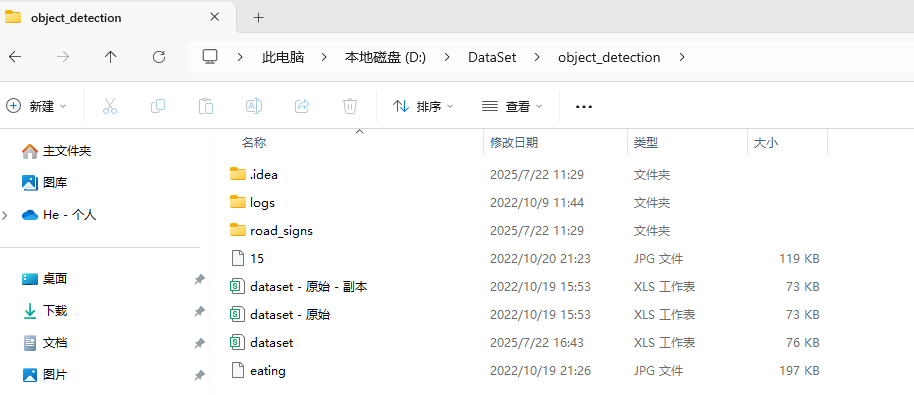Pytorch实现目标检测
import osimport randomimport pandas as pdimport numpy as npimport cv2from sklearn.model_selection import train_test_splitimport torchfrom torch.utils.data import Dataset, DataLoaderimport torch.nn as nnimport torch.nn.functional as Ffrom torchvision import models#配置设备device = torch.device(\"cuda\" if torch.cuda.is_available() else \"cpu\")class RoadDataset(Dataset): def __init__(self, paths, bb, y): self.paths = paths.values self.bb = bb.values self.y = y.values def __len__(self): return len(self.paths) def __getitem__(self, idx): path = self.paths[idx] y_class = self.y[idx] # print(\"path==\",path) # 检查路径是否存在 if not os.path.exists(path): raise FileNotFoundError(f\"图片不存在:{path}\") # 尝试读取图片 img = cv2.imread(str(path)) if img is None: raise ValueError(f\"读取图片失败(可能损坏或格式错误):{path}\") # 后续处理 img = img.astype(np.float32) img = cv2.cvtColor(img, cv2.COLOR_BGR2RGB) / 255 y_bb = self.bb[idx] tmplist = y_bb.split(\' \') y_bb = [int(e) for e in tmplist] y_bb = torch.tensor(y_bb) img = torch.Tensor(img).permute([2,0,1]) return img, y_class, y_bbdf_train = pd.read_csv(r\"D:\\DataSet\\object_detection\\dataset.csv\", encoding=\"gbk\")# print(df_train)X = df_train[[\'new_path\', \'new_bb\']]Y = df_train[\'class\']X_train, X_test, y_train, y_test = train_test_split(X, Y, test_size=0.2, random_state=42, shuffle=False)train_ds = RoadDataset(X_train[\'new_path\'], X_train[\'new_bb\'], y_train)test_ds = RoadDataset(X_test[\'new_path\'], X_test[\'new_bb\'], y_test)train_loader = DataLoader(train_ds, batch_size=16, shuffle=True)test_loader = DataLoader(test_ds, batch_size=16)#定义目标检测网络class Detect_model(nn.Module): def __init__(self): super().__init__() resnet = models.resnet34(weights=models.ResNet34_Weights.IMAGENET1K_V1) layers = list(resnet.children())[:8] # 取ResNet的前8层 self.features = nn.Sequential(*layers) # 用于图像特征提取 # 修正classifier:将BatchNorm2d改为BatchNorm1d(适应2D输入) self.classifier = nn.Sequential( nn.BatchNorm1d(512), # 改为1D批归一化(输入是2D张量) nn.Linear(512, 4) # 假设分类任务有4个类别,根据实际情况调整 ) self.bb = nn.Sequential( nn.BatchNorm1d(512), nn.Linear(512, 4) # 边界框预测(x1,y1,x2,y2) ) def forward(self, x): o = self.features(x) # 4D: [batch, 512, h, w] o = torch.relu(o) o = nn.AdaptiveAvgPool2d((1, 1))(o) # 4D: [batch, 512, 1, 1] o = o.reshape(x.shape[0], -1) # 2D: [batch, 512] return self.classifier(o), self.bb(o) # 此时输入classifier的是2D,与BatchNorm1d匹配# ============================detect_model = Detect_model().to(device)paramters = filter(lambda p: p.requires_grad, detect_model.parameters())optimizer = torch.optim.Adam(paramters, lr=0.001)# --------------------------detect_model.train()for ep in range(200): for k, (x, y_class, y_bb) in enumerate(train_loader): x, y_class, y_bb = x.to(device), y_class.to(device).long(), y_bb.to(device).float() pre_y, pre_bb = detect_model(x) loss_class = F.cross_entropy(pre_y, y_class, reduction=\'sum\') loss_bb = F.l1_loss(pre_bb, y_bb, reduction=\'none\').sum(1) loss_bb = loss_bb.sum() loss = loss_class + 0.001 * loss_bb optimizer.zero_grad() loss.backward() optimizer.step()# --------------------------------------detect_model.eval()correct = 0for k, (x, y_class, y_bb) in enumerate(test_loader): x, y_class, y_bb = x.to(device), y_class.to(device).long(), y_bb.to(device).float() pre_y, pre_bb = detect_model(x) _, pre_index = torch.max(pre_y, 1) t = (pre_index == y_class).int().sum() correct += tcorrect = 1. * correct / len(test_loader.dataset)print(\"在测试集上的分类准确率为:{:.2f}%\".format(100 * correct.item()))在测试集上的分类准确率为:90.34%
使用的数据集是:Kaggle上的Road Sign Detection数据集。该数据集共有877张图片。各图片大小不一
 因为使用了OpenCV所以各种路径中不能有中文。这个是一定要注意的。
因为使用了OpenCV所以各种路径中不能有中文。这个是一定要注意的。


